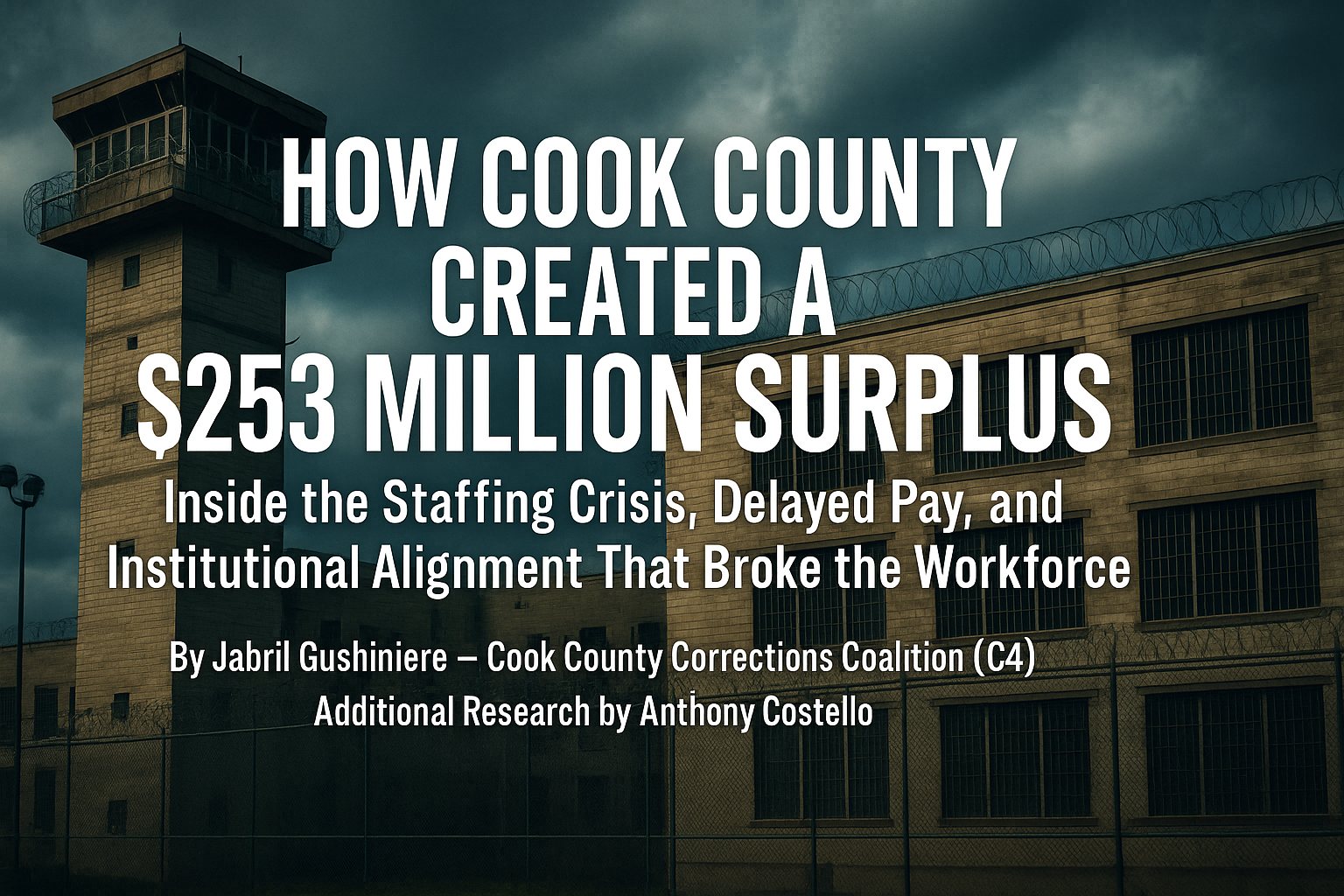C4 News
Broken on the Job, Silenced on the Record: How Cook County Treats Injured Officers

Executive Summary
Cook County correctional officers injured on duty face a deliberate system of attrition. Their pay is cut to 66.7% under workers’ compensation, “light duty” is capped at six months and renamed Temporary Work Assignment, and Independent Medical Examiners (IMEs) are used to overrule treating physicians and terminate benefits. Human Resources converts ADA accommodations into bureaucratic traps, ignores medical restrictions, and forces officers to bid by phone with no transparency. The Office of Professional Review (OPR) then closes retaliation complaints with its standard phrase - “insufficient evidence” - even when video, witnesses, or written proof exist.
Across Illinois, other law-enforcement agencies either receive 100 percent pay under the Public Employee Disability Act (PEDA) or have negotiated equivalent coverage in their collective-bargaining agreements. Cook County stands alone: the most violent jail in the state, with the least protection for the people who keep it standing.
This investigation, based on FOIA records, court filings, and officer testimony, reveals how Cook County uses medical bureaucracy to evade legal duties owed to its own correctional officers.
How the Paycheck Becomes Leverage
Under 820 ILCS 305 (Illinois Workers’ Compensation Act), injured employees must receive medical care and wage replacement at roughly two-thirds of their salary. Payments are to begin within 14 days and follow a regular schedule. In Cook County, those timelines break down. Officers describe missed checks, weeks-long delays, and sudden mail issues that leave them without income.
“I went weeks without a comp check. You can’t rehab when you’re choosing between therapy and rent.” - Correctional Officer, Division 10
On a gray Tuesday in early spring, an officer sat by his window, watching for the mail truck that never came. His shoulder throbbed from a surgery he rushed back from too soon. Each passing day without a check deepens the anxiety - not just about bills, but about what it meant to be disposable. The next envelope he received wasn’t his pay check; it was a notice scheduling an Independent Medical Exam, an appointment with a stranger who would decide if his pain still counted.
The result is predictable: officers return to work before healing because the alternative is financial collapse. “Heal or go broke” has become county policy in all but name.
Documented figures
• 524 IOD cases in 2023 [FOIA R053891] - one in five officers injured.
• 461 batteries to staff in the first half of 2025 [FOIA R076705] - almost three per day.
• 109 resignations from Jan 2024 to Jan 2025 [FOIA R076705] - a drain of experience and morale.
High violence, high injury, high attrition - and a payroll system that penalizes the wounded.
How “Light Duty” Becomes a Countdown
Illinois law does not limit how long an employee may remain on restricted duty if medical necessity continues. Cook County does. By relabeling “light duty” as a “Temporary Work Assignment” and imposing a six-month cap, the county circumvents the ADA’s requirement for individualized accommodation.
When the clock runs out, officers are pulled off payroll or told to seek disability. There is no review, no dialogue, and no record of alternatives considered.
“They call it light duty. We call it a countdown.” - Veteran Officer
This “countdown” violates the spirit of 42 U.S.C. §12112(b)(5)(A) and 29 C.F.R. §1630.2(o)(3), which requires an employer to engage in an interactive process to determine reasonable accommodation. A fixed limit is not a process. It is a deadline for elimination.
How IMEs Override Medical Judgment
An Independent Medical Examiner is not a doctor of record and owes no duty of care to the employee. Within Cook County, the IME has become a bureaucratic weapon. Officers describe the sequence:
1. Treating physician sets restrictions.
2. IME conducts a brief consult declares “fit for full duty.”
3. Risk Management uses the IME to override the treating doctor.
4. Wage replacement ends; officer must return or lose pay.
“The IME doctor doesn’t treat you. They write what the county needs them to write.” - Correctional Officer, Division 6
Under 42 U.S.C. §12112(d)(4) and the Seventh Circuit’s ruling in Nawara v. Cook County (2025), medical examinations must be job-related and consistent with business necessity; blanket fitness exams or forced medical disclosures violate the ADA. Cook County continues to ignore that standard.
How HR Weaponizes Return-to-Work
Human Resources in the Sheriff’s Office has become a gatekeeper for attrition, not recovery. Officers returning from injury describe:
• No interactive process. Restrictions ignored, responses verbal and undocumented.
• Six-month termination. Once Temporary Work Assignment expires, placement ends.
• Phone-in bids. Officers ordered to select assignments without vacancy lists or written confirmation.
• Mail-only comp pay. Checks arrive late, violating 820 ILCS 115/3, which requires semi-monthly payment no later than 13 days after the pay period.
One deputy, now the subject of pending federal ADA and FMLA complaints, recorded a nearly identical sequence: confidential medical information broadcast over radio, repeated demands for documents already submitted, and termination of light duty with no ADA review or discussion of alternative work. Her final report notes, “No ADA review provided … effective removal without placement.”
“Other cops in Illinois get full pay when they’re hurt. We get two-thirds and a moving target.” - Correctional Officer
Cook County routinely tells injured officers that the ADA does not apply because their injury is “not permanent.” This position misinterprets federal law. Under the ADA Amendments Act (ADAAA) and EEOC regulations, an impairment expected to last fewer than six months may still be a “substantial limiting” impairment. In Summers v. Altarum Institute Corp. (4th Cir. 2014), the court held that a temporary leg injury lasting several months could qualify as a disability under the ADA. The EEOC’s Final Rule and Q&A guidance confirm that duration alone does not decide coverage; severity and impact do.
Legal Note: The ADA defines “disability” as a physical impairment that substantially limits one or more major life activities. The ADAAA and EEOC regulations clarify that permanence is not required; even impairments lasting fewer than six months can qualify if their effect is substantial. (Summers v. Altarum Institute Corp., EEOC Final Rule Q&A, 29 C.F.R. §1630.2(j)(1)(ix)).
How OPR Silences Complaints
The Office of Professional Review exists to investigate misconduct. Officers describe it as a shield for the administration. Reports of retaliation and threats frequently boomerang into new cases against the reporting officer.
• A director’s threat reported to OPR becomes an OPR file on the officer for “unprofessional conduct.”
• A retaliation complaint is closed without interview or record review.
• The closure letter arrives with the stock phrase: “insufficient evidence.”
Example: On Feb 3, 2022, a supervisor accused an officer of being off post. Video showed the officer at the tier threshold. OPR nonetheless closed the case as “insufficient evidence.”
“OPR didn’t clear me. The video did. OPR just refused to say it.” - Correctional Officer
The pattern is systemic: complaints of ADA retaliation, false FMLA entries, or director misconduct are inverted into investigations of the complainant. The phrase “insufficient evidence” has become Cook County’s official mechanism for silencing proof.
Cook County vs. Everyone Else: The PEDA Divide
5 ILCS 345 (Public Employee Disability Act) grants qualifying first responders’ 100 percent of salary for up to 365 days after an on-duty injury. Its home-rule carve-out exempts jurisdictions over one million residents - covering Chicago and Cook County - but most agencies outside that exception are protected by law.
Even the Chicago Police Department, though excluded from PEDA by statute, negotiated equivalent coverage through its union contract: 12 months of full-pay IOD and explicit consideration of treating providers when determining fitness to return. State Police and suburban departments (DuPage, Lake, Kendall) all operate under PEDA or CBA equivalents.
Cook County officers get neither. No PEDA. No contract match. 66.7% pay. Six-month cap. Delayed checks.
This is not a budgetary constraint; it is a policy decision.
The Numbers That Don’t Lie
This section explains how full injury coverage is financially possible right now within Cook County’s own budget.
In Fiscal Year 2025, the Cook County Department of Corrections budgeted $369.9 million in personnel costs for 2,997 positions, representing the operational staff responsible for jail security and support - primarily correctional officers, sergeants, lieutenants, and unit-level civilian staff. Executive and command-level salaries are budgeted separately under the Sheriff’s Bureau of Administration, not within this DOC personnel total.
The Sheriff’s total budget across all bureaus reached $559.4 million, funding 5,583 positions agency wide.
Based on this ledger, providing PEDA-equivalent full-pay coverage to the 524 officers injured on duty in 2023 would cost between $13.9 million and $21.6 million annually, depending on whether base wages ($79,600 average) or full personnel cost per FTE ($123,400 approximate) is used. Even at the higher estimate, this represents less than 4 percent of the Department’s personnel budget or roughly 2.5 percent of the Sheriff’s total appropriation - a negligible fraction for a policy that would protect the workforce responsible for the jail’s security.
The fiscal record proves what policy denies: Cook County could fund full-pay injury coverage for every correctional officer without increasing its budget by even five percent. This is not a matter of funding; it is a matter of priorities.
“It’s not a money problem. It’s a priority problem.” - Veteran Officer
FOIA records also reveal that Cook County reported only six retaliation cases in total - despite dozens of documented complaints from officers across multiple divisions. The gap underscores a pattern of concealment, where official data sanitizes the reality of widespread administrative abuse.
Testimony and Pattern
Across C4 documentation and officer accounts, the same pattern repeats:
• IME reports overrule medical treatment.
• Six-month deadlines replace accommodations.
• Reduced pay forces early returns.
• OPR closures erase retaliation evidence.
Multiple officers, now part of C4’s leadership, describe HR and OPR as two ends of the same mechanism - one to reduce costs, the other to suppress accountability. Their accounts, corroborated through FOIA records and verified communications, form a consistent narrative: the county protects the budget, not the badge.
“Human Resources at Cook County Jail does not exist to protect the worker. It exists to protect the County.” - Beneath the Badge
Compliance and Correction
Legal alignment requires no new statute - only obedience to existing law:
1. Adopt PEDA-equivalent coverage: 100 percent pay for up to 365 days of verified IOD.
2. End the six-month cap: Replace with individualized ADA interactive reviews.
3. Restrict IME use: No override of treating physician without objective evidence and neutral review.
4. Enforce timely pay: Direct deposit and statutory compliance with 820 ILCS 115/3.
5. Document bidding: Publish vacancies, log offers, provide written assignments.
6. Audit OPR closures: Require factual summaries explaining each “insufficient evidence” finding.
7. Transparency: Quarterly public release of IOD counts, IME usage, staff assaults, resignations, and director payroll totals.
The Cost of Neglect
Every resignation, every premature return to duty, every ignored injury carries a hidden cost. When officers work through pain, mistakes multiply. When experience walks out the door, replacements arrive untrained and under-supported. The result is not only unsafe for officers — it is unsafe for detainees and taxpayers. Staffing shortages drive overtime, burnout, and escalating medical claims. The county saves dollars on paper while spending lives in practice.
Cook County’s jail will not get safer by breaking the people who protect it.
“We aren’t asking for sympathy. We’re asking to be treated like human beings when we get hurt doing our jobs.”- Correctional Officer, C4 testimony (2024)
The law is already written. The data is already public.
Only the will to comply is missing.
A Final Word to Every Officer
If you are a Cook County correctional officer dealing with an injury on duty, struggling with delayed compensation, or unsure how to navigate the workers’ compensation system, you are not alone.
The Cook County Corrections Coalition (C4) was created for this exact purpose — to protect officers, ensure fair treatment, and connect you with the help you deserve.
We can assist you in:
• Understanding your Injury on Duty (IOD) rights and benefits
• Navigating communication with Risk Management, HR, and OPR
• Finding a reputable workers’ compensation attorney who specializes in law enforcement cases.
• Reviewing your medical restrictions and ADA protections before you return to work.
Every officer deserves to recover with dignity, not fear.
If you need help, guidance, or legal support, contact the Coalition directly through our website.
C4 exists to make sure you’re never left fighting alone.
Sources
Appendix — Plain-Language Workers’ Comp Primer (Illinois)
• Rights (820 ILCS 305): Employer-paid medical care and roughly 66.7 percent wage replacement.
• Timing: Payments must begin within 14 days and continue regularly; delays are violations.
• Documentation: Ensure treatment notes specify restrictions and pain levels to prevent IME misuse.
• Red flags: Pressure to return, sudden IME scheduling after steady progress, missing checks, phone bids without vacancy data, or HR requests for private medical details beyond necessity.
Method and Sources
• FOIA R053891 (2023 IOD Records) – Cook County Sheriff’s Office
• FOIA R076705 (2025 Batteries to Staff and 2024–25 Resignations)
• Retaliation FOIA (2025) – Only six cases disclosed
• Illinois FOIA Statute (5 ILCS 140): https://www.ilga.gov/legislation/ilcs/ilcs3.asp?ActID=3126&ChapterID=57
Legal Citations
• Illinois Workers’ Compensation Act (820 ILCS 305): https://www.ilga.gov/legislation/ilcs/ilcs3.asp?ActID=2430&ChapterID=68
• Illinois Wage Payment and Collection Act (820 ILCS 115): https://www.ilga.gov/legislation/ilcs/ilcs3.asp?ActID=2402&ChapterID=68
• Public Employee Disability Act (5 ILCS 345): https://www.ilga.gov/legislation/ilcs/ilcs3.asp?ActID=1702&ChapterID=61
• Americans with Disabilities Act (42 U.S.C. §12112 & §12112(d)(4)): https://www.law.cornell.edu/uscode/text/42/12112
• EEOC Regulations (29 C.F.R. §1630.2(o)(3)): https://www.ecfr.gov/current/title-29/subtitle-B/chapter-XIV/part-1630/section-1630.2
• Family and Medical Leave Act (29 U.S.C. §§2601–2654): https://www.law.cornell.edu/uscode/text/29/chapter-28
• Case Law
• Nawara v. Cook County (7th Cir. 2025)
• Ziccarelli v. Dart (7th Cir. 2025)
• Summers v. Altarum Institute Corp. (4th Cir. 2014): https://casetext.com/case/summers-v-altarum-inst-corp
Budget
• Cook County Sheriff’s Office FY2025 Budget (Volume II Annual Appropriation): https://www.cookcountyil.gov/sites/g/files/ywwepo161/files/documents/2025-02/Volume%202%20%20Adopted%202025_Web.pdf
• Department of Corrections Personnel: $369,911,000 (2,997 positions) — contained within above PDF
• Sheriff’s Office Total: $559,411,489 (5,583 positions) — https://cookcountysheriffil.gov/wp-content/uploads/2025/05/CCSO-FY25-Budget-website-doc-002.pdf
Records and Testimony
• Verified C4 Officer Filings and Public Statements – https://www.c4cookcounty.org
• Beneath the Badge Whistleblower Report – Published via C4 Media (2025)
Unicorn Riot Feature: “Whistleblower’s Account of Corruption and Administrative Abuse within Cook County Jail” (2025): https://unicornriot.ninja/2025/whistleblowers-account-of-corruption-and-administrative-abuse-within-cook-county-jail
JOIN THE COALTION
You Wear the Badge. Now Join the Movement.
You deserve to be protected at work, to be compensated for your service, and respected for your actions. We will advocate for you. Whether you are a part of C4 or not, you deserve to have the protections we are fighting for, for yourself, for your family, and for your future. We must stand united. We will fight for you and the time to fight is now.
Join C4
Join the movement. Join the fight. Stand united.
We will provide you with a welcome email, informationals, invitations to meetings, and any advocacy support you may need.




